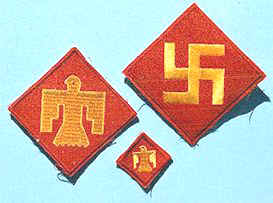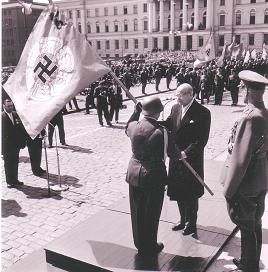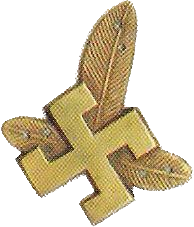I open this topic to compilate pictures of the “hakenkreuz” ( hooked cross in german) in use before 1933 and also in others non-german military services.
Is incredible the widespread aplication of this now sinister simbol.
U.S army aircraft in 1929.


I open this topic to compilate pictures of the “hakenkreuz” ( hooked cross in german) in use before 1933 and also in others non-german military services.
Is incredible the widespread aplication of this now sinister simbol.
U.S army aircraft in 1929.

45th Infantry division

http://www.m38a1.com/Misc-MV/thunderbirds.htm
http://www.45thdivisionmuseum.com/History/SwastikaToThunderbird.html
A blue swastika was adopted as the insignia of the Finnish Air Force on 18 March 1918 (- 1945).
http://swastika-info.com/en/startpage/finland/1061679609.html
_
Why did the Nazys have to ruin stuff?

Also, the Swastika was used as a good luck charm by aviators like Lindburg.

Bhudist monastry.
In some countries, a Buddist monastry or temple is marked by a swastika.
At the risk of telling you something you already know, it’s an ancient symbol that crosses many cultures and continents.
Here’s one summary.
Japanese martial art called ‘kempo’ has swastika as it s emblem
Thanks guys for the images, yes I know that was an hindu symbol but I am more interested in the western usage of it. Amazing the one used by the Infantry Division. :shock:

Good luck charm. I guess its like a clover.
Tell the german people about good luck with that :rolleyes:
A primitive swastica, very much like the finnish one painted on the isde of Werner Voss airplane ww1.

Again ww1, the one in the side of french-american ace Raoul Luftbery.

More swastikas for america and good luck.

Very good , amazing the one with the baby. 
Backwards swastika on Japanese map. (symble for Bhuddist monastry or temple)

well swastika was used in ancient Europe by many nations
but now if you gonna use it your gonna be blamed as a nazi
but before 1939 it was common to see swastika around the worl
Yea , especially if keep in mind the fact that ideas of national-socialism wasn’t so bad looking befor the 1939 in some of states…
The Honourable Finnish Swastika
By Mr. Aarne Ellilä, World War II bomber pilot
Original Finnish language article translated into English on February 2007 by Ossi Juntunen
Anti-Semitism used to be widespread in Europe. As the Nazis took over in 1932 in Germany, the systematic persecution of Jews commenced, and after the outbreak of war, systematic genocide. The Holocaust and the occupation of European countries by the Wehrmacht resulted in making the tilted swastika ? the insignia of antisemitists since the end of the 1800s - the symbol of evil. The Nazi Swastika also tainted the Finnish Level Swastika, originating from the year 1918.
These two insignias share the shape but the symbolic content is completely different. They share no background. An uninformed person cannot tell them from apart: he does not know that the German symbol, tainted as evil is not the same as the Finnish, untainted and honourable swastika, and he abhors both. The Swastika is an ancient sign of luck originating from Asia, widespread in the world. Even today it is recognized as the insignia of the Falun Gong. The Swastika is included in the Finnish ornamentics for ages. By an extraordinary chance it was adopted to symbolic use at the same time but independently in Germany and in Finland.
In Finland the Swastika was introduced in the high art included in the frame of the painting ?Aino? by Akseli Gallen-Kallela in 1889, now owned by the Bank of Finland. The Swastika was decorating the Fennia series dishes by Arabia ceramics factory in the age of Art Noveau. The Swastika was first used by the government in 1918, in the Cross of Liberty decoration designed by Gallen-Kallela, and as the national insignia of the Finnish Air Force. Swedish Count Eric von Rosen had donated the first FiAF aircraft, decorated by swastikas painted on the wings.
Thus the Swastika was introduced by two sources by two men in two different manifestations. The other national symbols of the young Finnish state included the national coat of arms from the 1500’s, the national anthem and the blue cross flag from the year 1918.
The German National Socialist Party, founded in 1919, adopted an ideologically correct red flag with a white roundel including a slanted swastika. The slanted swastika had been since the end of the 1800s the symbol of antisemitists in Germany and Austria. After Hitler took over in 1933 that flag became two years later the German national flag. The tilted Nazi Swastika vanished from view in 1945.
War of Independence breaks out
The Finnish Senate (Cabinet) nominated on the 28.1.1918 Gen.Lt C.G.E.Mannerheim (1867-1951) as the Commander- in-Chief of the legal government troops. The very same day the troops were ordered to disarm the Russian garrisons, foreign troops, in Ostrobothnia. The War of Independence had been started.
Cross and Medals of Liberty
The G-in-C understood the significance of acknowledgment by decorations. He recalled painter Akseli Gallen-Kallela, 53 years in age, from the front and ordered him to design the decorations. At Mannerheim?s suggestion the senate temporarily decreed on the 4. March 1918 about the Cross of Liberty and Medal of Liberty decorations. The Senate was to award the decorations but the task was delegated to the G-in-C except for the highest decorations. The military or civil rank of the receiver decided the rank of the decoration.
The crosses had five ranks and the medals two. The design drawings were dated 3.3.1918. The Cross of Liberty is comprised of the St. George?s cross superimposed by a Swastika. The Grand Cross and the 1st class Cross include a star carried on breast, featuring a swastika with a rose superimposed. The decoration grades are differentiated by size and material.
One essential part of a decoration is the ribbon. The Grand Cross and 1st and 2nd class crosses were carried on yellow ribbons, 3rd and 4th class featured red ribbons. The colours were adopted from the “lion flag” preceding the present blue-white flag. A decoration awarded for military valour is hanging from a metal wreath of laurels comprising armoured arms holding swords, symbolizing East and West ? coat of arms of Carelia. The decoration is then awarded ?with swords?. Decorations for civil and medical valour the ribbon does not include the swords. 1st Class Medal of Liberty is carried on a blue and 2nd class Medal of Liberty on a red ribbon. The medal features the words “urheudesta, för tapperhet” (for courage, Finnish and Swedish), on the reverse: “Suomen kansalta 1918” (From the people of Finland in 1918).
The Crosses and Medals of Liberty were not awarded after 28 Jan 1919 by the decree of Regent Mannerheim (Gen. Mannerheim was nominated as the Regent until a presidential election could be arranged, tr. rem.). Two Grand Crosses had been awarded by the Senate, one with swords to Cavalry General (12.3.1918) C.G.E. Mannerheim and another for civil merits to Senator P.E. Svinhufvud. While Crossed of Liberty and Medals were no more awarded, the Finnish White Rose order was created.
Memorial medal for the War of Independence was created on the 10.9.1918, designed by Akseli Gallen-Kallela. The front of the medal includes the Cross of Liberty, armoured arms with swords and ?1918?. The reverse includes the Lion of Finland. The ribbon is blue with two black stripes.
The Cross or Medal of Liberty was awarded to more than 23 000 Finnish citizens. German soldiers who had been fighting in Finland were awarded about 3500 decorations. Volunteers from Sweden and other countries were awarded 1500 decorations.

Full article here:
http://www.virtualpilots.fi/feature/articles/honorable_swastika/
Check out fylfot here
http://www.heraldsnet.org/saitou/parker/Jpglossf.htm
and widespread usage in a solid British institution here
http://www.scouting.milestones.btinternet.co.uk/swastika.htm
badges of Polish Mountain Infantry :


A bit from Soviet Russai , 1918.
http://img208.imageshack.us/my.php?image=ussrsocialistswastika19nw6.jpg
http://img20.imageshack.us/my.php?image=ussrsocialistsovietswasha4.jpg
Australia.
Medal of Australian boyscouts: http://img401.imageshack.us/my.php?image=nla1qh2.jpg
The moonument for the falen in WWI with the wreth from the local national-socialists: http://i-grappa.livejournal.com/382140.html?style=mine